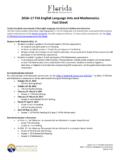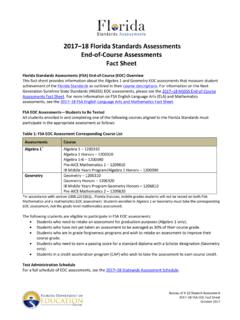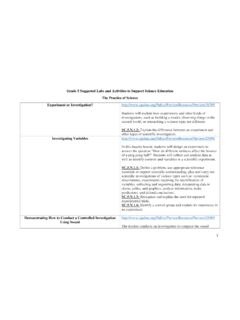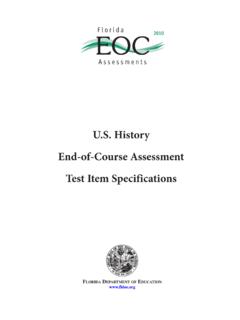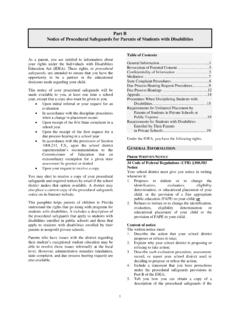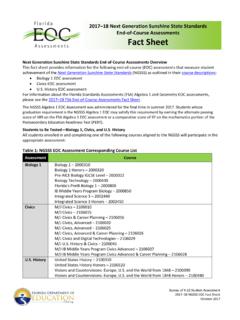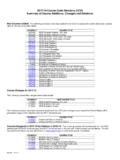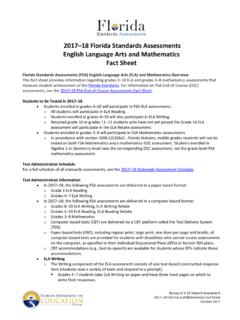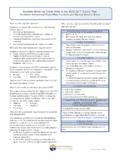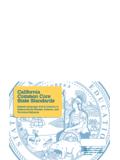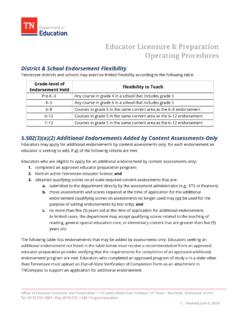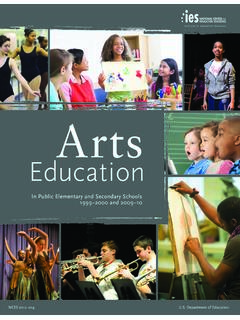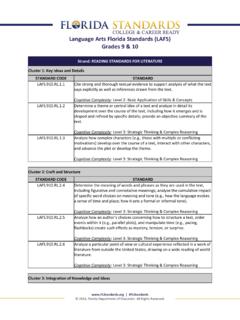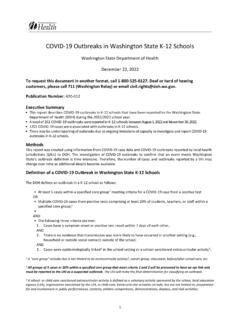Transcription of Language Arts Florida Standards (LAFS) Grade 6
1 Language arts Florida Standards (LAFS). Grade 6. Strand: READING Standards FOR LITERATURE. Cluster 1: Key Ideas and Details STANDARD CODE STANDARD. Cite textual evidence to support analysis of what the text says explicitly as well as inferences drawn from the text. Cognitive Complexity: Level 2: Basic Application of Skills & Concepts Determine a theme or central idea of a text and how it is conveyed through particular details; provide a summary of the text distinct from personal opinions or judgments. Cognitive Complexity: Level 2: Basic Application of Skills & Concepts Describe how a particular story's or drama's plot unfolds in a series of episodes as well as how the characters respond or change as the plot moves toward a resolution.
2 Cognitive Complexity: Level 2: Basic Application of Skills & Concepts Cluster 2: Craft and Structure STANDARD CODE STANDARD. Determine the meaning of words and phrases as they are used in a text, including figurative and connotative meanings; analyze the impact of a specific word choice on meaning and tone. Cognitive Complexity: Level 3: Strategic Thinking & Complex Reasoning Analyze how a particular sentence, chapter, scene, or stanza fits into the overall structure of a text and contributes to the development of the theme, setting, or plot. Cognitive Complexity: Level 3: Strategic Thinking & Complex Reasoning Explain how an author develops the point of view of the narrator or speaker in a text.
3 Cognitive Complexity: Level 2: Basic Application of Skills & Concepts Cluster 3: Integration of Knowledge and Ideas | #FLStandards 2014, Florida department of education . All Rights Reserved. STANDARD CODE STANDARD. Compare and contrast the experience of reading a story, drama, or poem to listening to or viewing an audio, video, or live version of the text, including contrasting what they see and hear when reading the text to what they perceive when they listen or watch. Cognitive Complexity: Level 3: Strategic Thinking & Complex Reasoning Compare and contrast texts in different forms or genres ( , stories and poems; historical novels and fantasy stories) in terms of their approaches to similar themes and topics.
4 Cognitive Complexity: Level 3: Strategic Thinking & Complex Reasoning Cluster 4: Range of Reading and Level of Text Complexity STANDARD CODE STANDARD. By the end of the year, read and comprehend literature, including stories, dramas, and poems, in the grades 6 8 text complexity band proficiently, with scaffolding as needed at the high end of the range. Cognitive Complexity: Level 2: Basic Application of Skills & Concepts Strand: READING Standards FOR INFORMATIONAL TEXT. Cluster 1: Key Ideas and Details STANDARD CODE STANDARD. Cite textual evidence to support analysis of what the text says explicitly as well as inferences drawn from the text.
5 Cognitive Complexity: Level 2: Basic Application of Skills & Concepts Determine a central idea of a text and how it is conveyed through particular details; provide a summary of the text distinct from personal opinions or judgments. Cognitive Complexity: Level 2: Basic Application of Skills & Concepts Analyze in detail how a key individual, event, or idea is introduced, illustrated, and elaborated in a text ( , through examples or anecdotes). Cognitive Complexity: Level 2: Basic Application of Skills & Concepts Cluster 2: Craft and Structure STANDARD CODE STANDARD. Determine the meaning of words and phrases as they are used in a text, including figurative, connotative, and technical meanings.
6 | #FLStandards 2014, Florida department of education . All Rights Reserved. Cognitive Complexity: Level 2: Basic Application of Skills & Concepts Analyze how a particular sentence, paragraph, chapter, or section fits into the overall structure of a text and contributes to the development of the ideas. Cognitive Complexity: Level 3: Strategic Thinking & Complex Reasoning Determine an author's point of view or purpose in a text and explain how it is conveyed in the text. Cognitive Complexity: Level 3: Strategic Thinking & Complex Reasoning Cluster 3: Integration of Knowledge and Ideas STANDARD CODE STANDARD. Integrate information presented in different media or formats ( , visually, quantitatively) as well as in words to develop a coherent understanding of a topic or issue.
7 Cognitive Complexity: Level 3: Strategic Thinking & Complex Reasoning Trace and evaluate the argument and specific claims in a text, distinguishing claims that are supported by reasons and evidence from claims that are not. Cognitive Complexity: Level 3: Strategic Thinking & Complex Reasoning Compare and contrast one author's presentation of events with that of another ( , a memoir written by and a biography on the same person). Cognitive Complexity: Level 3: Strategic Thinking & Complex Reasoning Cluster 4: Range of Reading and Level of Text Complexity STANDARD CODE STANDARD. By the end of the year, read and comprehend literary nonfiction in the grades 6 8 text complexity band proficiently, with scaffolding as needed at the high end of the range.
8 Cognitive Complexity: Level 2: Basic Application of Skills & Concepts Strand: WRITING Standards . Cluster 1: Text Types and Purposes STANDARD CODE STANDARD. Write arguments to support claims with clear reasons and relevant evidence. a. Introduce claim(s) and organize the reasons and evidence clearly. b. Support claim(s) with clear reasons and relevant evidence, using credible sources and demonstrating an understanding of the topic or text. c. Use words, phrases, and clauses to clarify the relationships among claim(s) and reasons. | #FLStandards 2014, Florida department of education . All Rights Reserved. d. Establish and maintain a formal style.
9 E. Provide a concluding statement or section that follows from the argument presented. Cognitive Complexity: Level 3: Strategic Thinking & Complex Reasoning Write informative/explanatory texts to examine a topic and convey ideas, concepts, and information through the selection, organization, and analysis of relevant content. a. Introduce a topic; organize ideas, concepts, and information, using strategies such as definition, classification, comparison/contrast, and cause/effect; include formatting ( , headings), graphics ( , charts, tables), and multimedia when useful to aiding comprehension. b. Develop the topic with relevant facts, definitions, concrete details, quotations, or other information and examples.
10 C. Use appropriate transitions to clarify the relationships among ideas and concepts. d. Use precise Language and domain-specific vocabulary to inform about or explain the topic. e. Establish and maintain a formal style. f. Provide a concluding statement or section that follows from the information or explanation presented. Cognitive Complexity: Level 4: Extended Thinking &Complex Reasoning Write narratives to develop real or imagined experiences or events using effective technique, relevant descriptive details, and well-structured event sequences. a. Engage and orient the reader by establishing a context and introducing a narrator and/or characters; organize an event sequence that unfolds naturally and logically.

